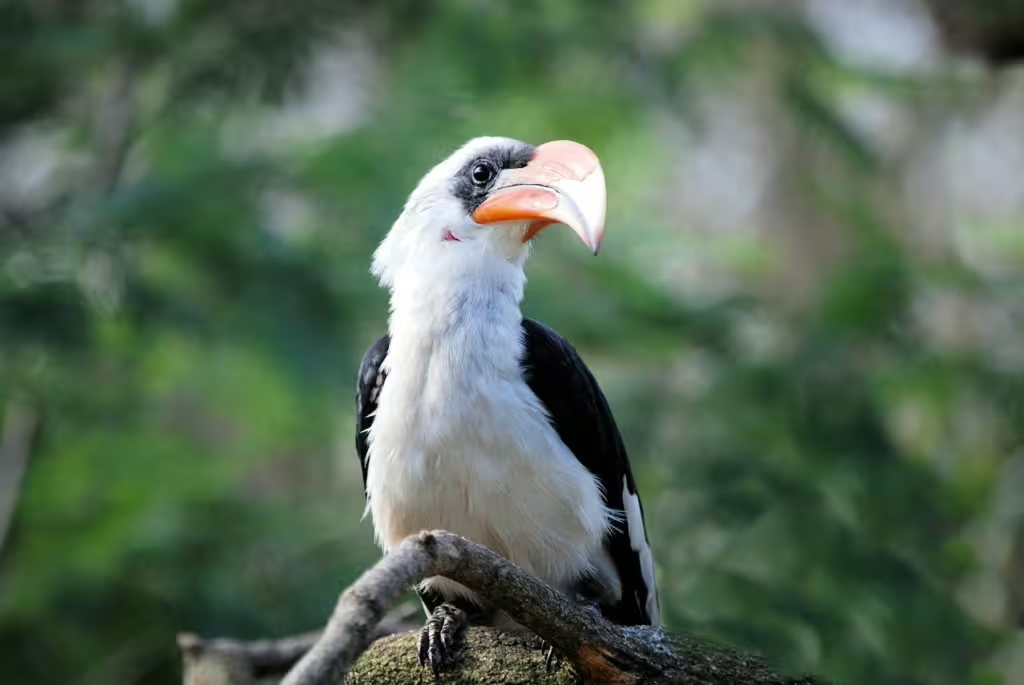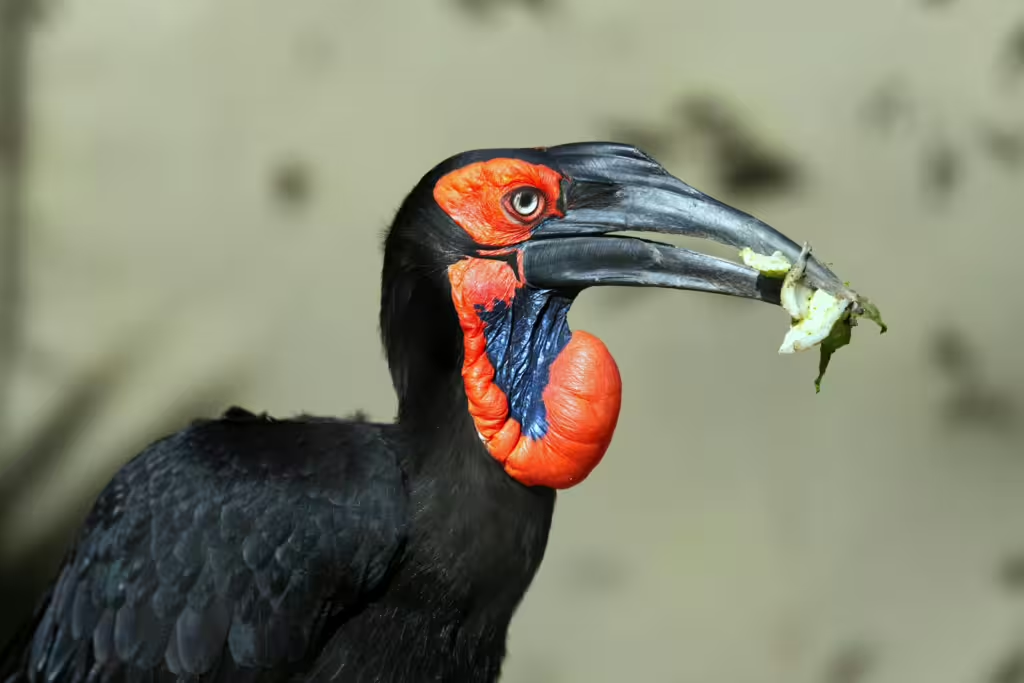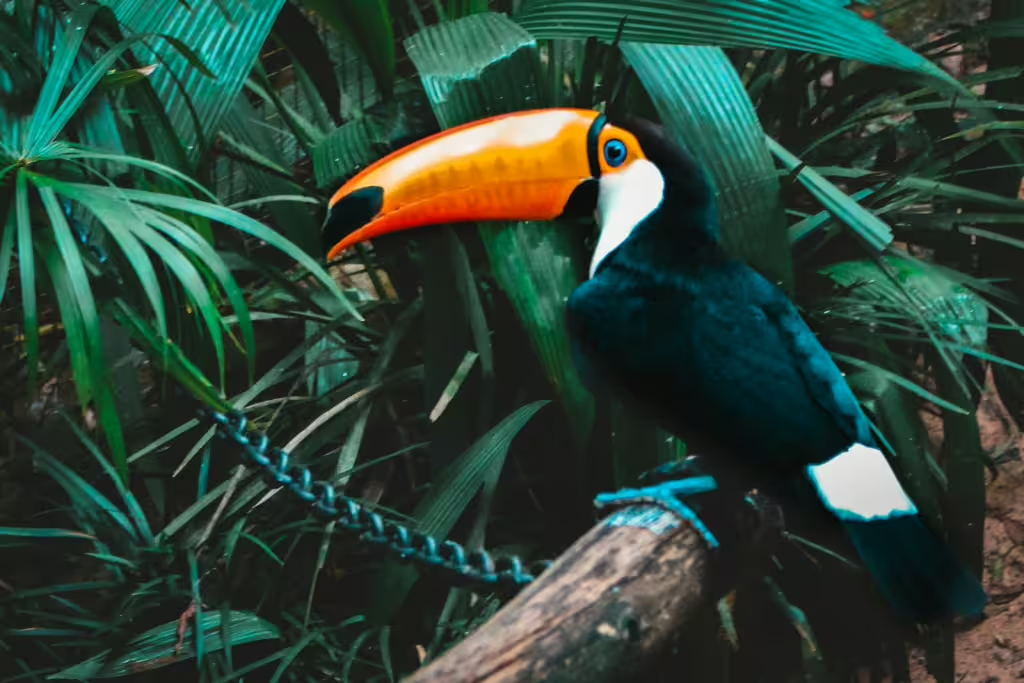Whether you are familiar with them from The Lion King, Encanto, or the front of a box of Fruit Loops, hornbills and toucans are some of the most easily recognizable birds in popular culture. In fact, even if you’d never seen a single Disney movie or been down the aisle of a grocery store, chances are good you’ve been fortunate enough to behold the bodacious beaks on these beautiful birds at some point in your life.
Toucans and hornbills are most easily identified by virtue of their most extraordinary beaks. These colorful and appendages look as though they are almost oversized, giving the indication that they are just for show and nothing else. But that could not be further from the truth. Long-time readers will understand the precept that “nature doesn’t make mistakes” quite well. And these remarkable beaks play a critical role in the survival of their attached birds, as well as the ecosystems the animals themselves inhabit.
In this article, we will delve into the fascinating world of both toucans and hornbills, two unique breeds of bird that have more in common than their similar faces might indicate. As we do, we will explore their unique adaptations, as well as their individual ecological importance. Finally we will speak about the conservation challenges and ecological threats they face each day.
Toucans: Icons of the Tropics
Species Overview
Toucans are tropical birds, native to the rainforests of Central and South America. There are over 40 species in the toucan family, otherwise known as Ramphastidae. Other related species within that family are the toucanets, smaller, large-billed cousins of the toucan, and aracaris, which look quite similar to adult toucans but with different colorations. All birds within the family Ramphastidae are characterized by their large, colorful bills and vibrant plumage. Perhaps the most notable species include these three mentioned below:
Keel-billed Toucan (Ramphastos sulfuratus)
The keel-billed toucan, otherwise known as the “rainbow-billed” toucan, is one of the most iconic bird species that dwells in the tropics. This bird’s vibrant bill features a mix of green, orange, red, and blue hues, making it a striking sight in the rainforest canopy. To many, the toucan’s bill might seem overlarge or heavy, but it is actually quite lightweight. This is due to the fact that most toucan bills are made from keratin, the same material that makes up human hair and nails. This is also the same material that rhinoceros horns are made of, incidentally.
This species of rainbow-colored toucan is native to Central and South America, where it dines on mostly fruit. Although this bird is an adept fruit eater, it will occasionally consumes insects, eggs, and small lizards when it can get them. Like many birds, the toucan is a social creature and is often seen grouping together in small flocks, engaging in playful behaviors. It also has a distinct call that can be heard echoing through the rainforest. This, combined with its bright coloration, has made it a symbol of tropical biodiversity.
Toco Toucan (Ramphastos toco)
The largest and perhaps most well-known member of the toucan family is the toco toucan. This bird is easily distinguished by its vivid orange bill, which contrasts beautifully with its sleek black plumage and white throat. The toco toucan can be found primarily in South America, where it inhabits far more than just the jungle. In fact, this bird is equally at home in open woodlands and savannas as it is tropical rainforests. Its bright orange bill is surprisingly light and multifunctional, used for thermoregulation, reaching fruit, and attracting mates.
In terms of their ecological roles, toco toucans act as valuable seed dispersers, aiding in forest regeneration. They have a charismatic appearance and friendly nature, which have made them highly popular in zoos and as mascots for a number of conservation programs. Unfortunately, this innate amiability has also made them desirable victims in the exotic pet trade.
Chestnut-mandibled Toucan (Ramphastos swainsonii)
The chestnut-mandibled toucan, also known as the Swainson’s toucan, is quite a stunning bird as well. This is a true rainforest native and it dwells in the rainforests of Central America. Like most toucans, its most distinguishing features are its yellow throat, contrasting black plumage, and the large reddish-brown-tipped bill that takes up most of its face.
The Swainson’s toucan is an agile forager that feed primarily on fruit but is not above consuming the occasional small animal now and then. The bird has a loud, croaking call that echoes through the forest and aids in communication with other members of its species. Nevertheless, the call is so loud and so distinctive, that it is often heard long before the actual bird itself is seen. Though habitat loss has affected its population, it is still an essential seed disperser for what remains of its rainforest home.

Habitat and Range
Toucans thrive best in tropical rainforests, where they tend to live in and around the upper canopy of the trees. This is the place where fruit, their preferred meal, is most abundant. Tropical to their bones, toucans prefer to dwell in warm, humid climates. This means that the Amazon Rainforest is kind of a stronghold for many species. That said, some subspecies can also be found living in montane forests. Braver individuals might even venture into human-altered landscapes on occasion and settle there.
Ecological Importance
Because their diets consist primarily of fruits, toucans play a pivotal role as seed dispersers in whatever environment they find themselves in. Their beaks allow them to consume the fruit whole, which breaks down during digestion, leaving the seeds to pass, mostly unharmed through their digestive system as droppings. The toucans make their “deposits” far enough from the parent tree that the seeds can then grow and mature in a new area, thereby aiding in both forest regeneration and biodiversity.
Threats to Toucans
Deforestation is one of the primary threats to most rainforest critters, so it also one of the toucans’ biggest problems. As rainforests are cleared for agriculture and logging, these remarkable birds lose their habitat and primary food sources. Sadly, the illegal pet trade has only made their problems worse and have further endangered their already dwindling populations.

Natural Predators
Snakes, hawks, and large cats like ocelots all prey on toucans. Meanwhile, their nesting sites in tree hollows are vulnerable to raiding by monkeys and other opportunistic mammals in search of a brightly-colored omelet.
Hornbills: Guardians of the Forest
Species Overview
Hornbills are another diverse group of birds with quite unique, often overlarge bills. You might think that because they share some similarities, that they are related to toucans, but that is not the case; though they do fit into a similar ecological niche. There are over 60 species of hornbills, each with its own unique adaptation. These birds are most often found primarily in Africa and Asia, and the some of the most recognizable examples are:
Great Hornbill (Buceros bicornis): The Great Hornbill is a large, striking bird. It’s has an impressive, bright yellow-and-black casque, which is a hollow structure located on top of its bill, as well as a long tail and white and black plumage. This species does best in environments that provide open canopies and ample tall trees, which is why it primarily inhabits the dense, tropical forests of India and Southeast Asia. The Great Hornbill has a diet that consists mainly of fruits, small mammals, and even other birds. This mostly fruit centric diet means that, like toucans, hornbills are valuable seed dispersers.
Rhinoceros Hornbill (Buceros rhinoceros): The Rhinoceros Hornbill is so-named because of its rhino hornlike casque that sits atop its bill and is used to both communicate and attract mates. This majestic bird is native to the tropical rainforests of Borneo and Sumatra. It has striking black and white plumage with a red-orange patch circling its eyes and around its neck. Like most hornbills, the Rhinoceros hornbill is omnivorous, feeding on a varied diet of fruits, insects, and small vertebrates.
Southern Ground Hornbill (Bucorvus leadbeateri): The Southern Ground Hornbill is actually terrestrial, which means it lives primarily on the ground. As a result, this bird can be found living in the savannas and woodlands of sub-Saharan Africa. It has predominantly black plumage, a vibrant red throat patch, and is quite large when compared to other hornbills. This throat pouch is displayed prominently during courtship rituals.
The southern ground hornbill’s includes insects, amphibians, small reptiles, and, you guessed it, fallen fruit. This hornbill is more social than some other species and can often be found living in small family groups. Unlike other hornbills that act primarily as seed dispersers, this bird’s role lies in controlling insect populations.
Habitat and Range
As you can tell, hornbills occupy quite an array of different habitats, from dense tropical rainforests to arid savannas. Asian hornbills tend to be predominantly forest dwellers, while African species like the ground hornbill have evolved to survive and hunt in more open landscapes. In most cases though, hornbills tend to be associated with old-growth forests, where they nest in large tree cavities.
Ecological Importance
Hornbills are vital to forest ecosystems because they disperse seeds. This not only helps maintain biodiversity, it helps to regenerate the depleted hectares of forest that are being hacked down by human beings each year. Meanwhile, other hornbill species act as pest controllers because they consume mostly insects and small vertebrates.
Threats to Hornbills
Habitat loss is the greatest threat to all tropical bird species, hornbills included. In Southeast Asia, where the proliferation of palm oil plantations has rendered countless acres of rainforests into agricultural wastelands, this problem has become so serious and ecosystem-ending that we struggle to put it into words. Additionally, hunting for their casques and feathers, as well as the illegal pet trade, have helped to contribute to population declines in every place where hornbills can be found.
Natural Predators
Hornbills are typically preyed-upon by large birds of prey like eagles, as well as arboreal snakes. Those snakes also target their nests when they can. Ground-dwelling species are even more vulnerable to predators and are eaten by jackals, leopards, and wild dogs.
The Anatomy of a Beak

Both toucans and hornbills are famous for their impressive beaks. The thing is, as similar as they might appear, the specific structure and function of these beaks differ significantly.
Toucans
Despite their size, toucan beaks are surprisingly lightweight. Made of keratin and supported by a spongy, hollow structure, the toucan beak is both strong and versatile.
- Thermoregulation: Toucans use their beaks as a way to dissipate heat, so they act as a natural cooling system for the bird’s face.
- Feeding: Living as they do in the trees, the toucan’s large bill enables them to reach and pluck fruit from even the highest, most inaccessible branches.
Hornbills
Hornbill beaks are more robust and often feature a structure known as a casque, which varies in size and shape among species. The casque’s functions are myriad.
- Amplifying Calls: In some species, the hornbill’s casque acts as a resonator, enhancing their calls over vast distances.
- Combat and Display: Male hornbills will usually flash their casques during fights for territory or mating rituals. The most brightly colored casques are used to attract mates and assert dominance.
How to Help
Support Conservation Efforts
The Rainforest Trust and BirdLife International are both valuable organizations that work tirelessly to protect the ever-dwindling habitats of toucans and hornbills around the world. It is important that individuals and governments support these initiatives so that they can continue to make a significant impact.
Advocate for Sustainable Practices
Reducing demand for palm oil and other environmentally-destructive products linked to deforestation can help preserve the forests that these birds call home.
Raise Awareness
As always, we must educate others about the importance of toucans and hornbills. Doing this can often inspire collective action that will enable us to protect these incredible birds for years to come.
True Investigator Says…
As you can see, toucans and hornbills may look similar, but they are very different. Despite these differences, however, their unique adaptations have allowed them to become vital to their respective ecosystems. Their vibrant plumage, fascinating behaviors, and ecological roles make them irreplaceable members of the natural world; but they need our help. The plight that these and so many birds face because of human beings is insurmountable without our intervention. We caused these issues and if we don’t work to fix them, then these amazing animals will be stricken from the Earth for good.
Discover more from TrueInvestigator
Subscribe to get the latest posts sent to your email.

